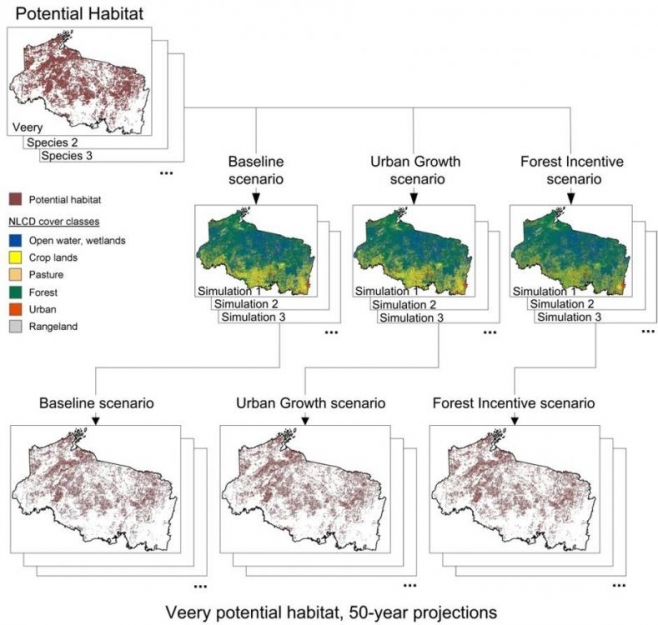Posted 08/9/10
Habitat loss is the major cause of declines in biodiversity, with land use being the major driver of habitat loss. Land use change is closely interlinked with economics and politics. Thus, combining ecological and economic information associated with land use change should help improve our understanding of the drivers of land use change and its ecological effects such as changes in the diversity and occurrence of forest birds.
Worldwide, habitat loss is the number one cause of decreasing biodiversity and the major source of habitat loss is land use. The combination of ecology and economy provides a good basis for improving our understanding of the drivers of land use change. In collaboration with resource economists and ecologists, post-doctoral research associate Frederic Beaudry studied forest bird diversity in relation to land use change in Northern Wisconsin, evaluating the effects of current and predicted changes in land use. ‘Northern Wisconsin is a great place to study land use change, because the area experienced a transition from forestry as the major land use to second home development and recreational use’, explains Beaudry, who has a background in wildlife ecology and a particular interest in conservation biology.

Within this project Beaudry uses long-term bird point count data to create models of potential habitat and combines this information with economic models of land use change. These economic models estimate the probability of transition between different land uses based on the net return per acre for a given land use, and the response of the transitions to different policy and market scenarios. Series of landscape simulations are built based on the estimated transition probabilities, and with those Beaudry and co-authors evaluate the effects the projected land use changes are likely to have on forest bird potential habitat in northern Wisconsin.

The impact of land use changes is not the same for all forest birds. ‘Under the current land use trends, bird species that breed in deciduous forest, such as the Wood Thrush, suffer the most potential habitat loss in the coming 50 years’, say Beaudry. In the future scenario simulations, habitat loss was somewhat mitigated by monetary incentives such as those used to favor carbon storage (e.g., a dollar amount per acre in tax credit for reforestation efforts on private lands). ‘Most surprising to me was the required level of incentives needed to effectively reduce habitat loss’, said Beaudry, ‘which means policy makers need to carefully think through incentive levels to ensure they actually are useful conservation measures.’ To further our understanding of the relationship between incentive levels and the mitigation of habitat loss, Beaudry and co-authors are now exploring the threshold levels of incentives necessary for effective habitat conservation on a national level.”
Story by Wiebke Neumann
